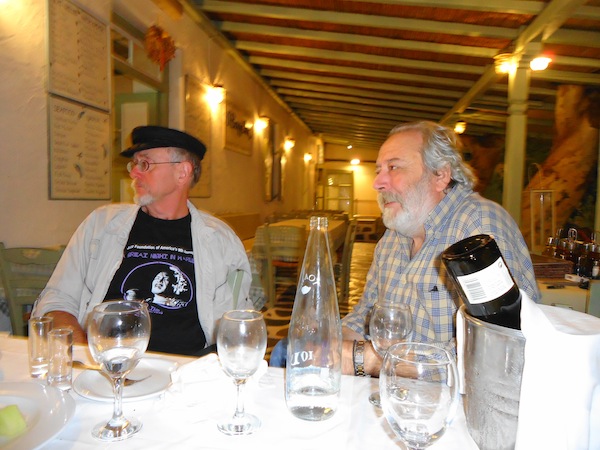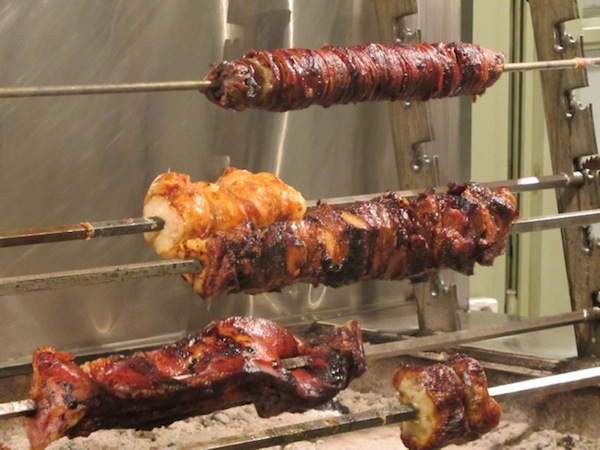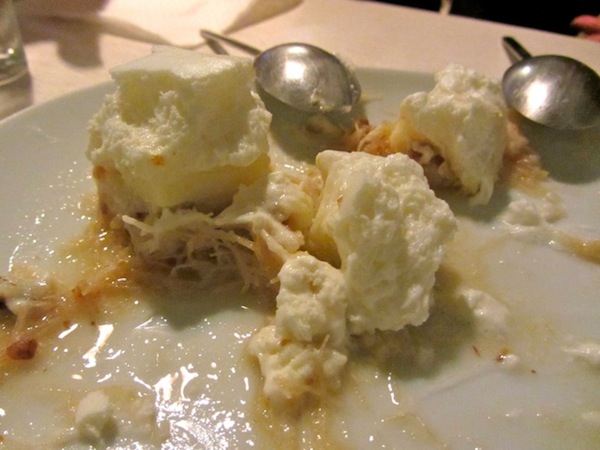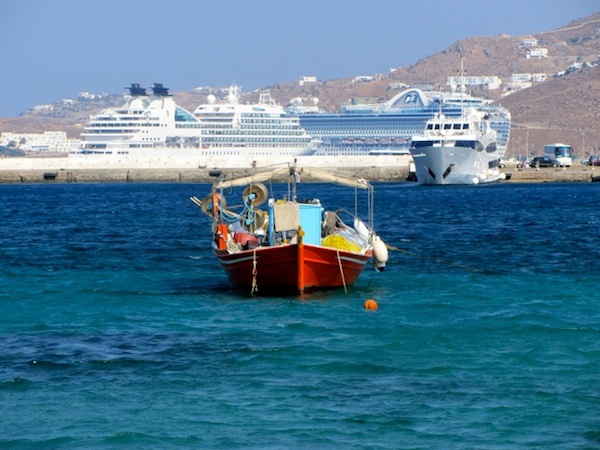24 Hours On Mykonos
Eating Well Is The Best Revenge
by Diana Farr Louis
ANDROS Greece—(Weekly Hubris)—10/10/11—We’ve been to fabled Mykonos enough times not to need to revisit, but when my dear friend, “The Fish,” confessed that her husband, Païdaki, “The Lamb Chop,” was allergic to Andros, it was obvious we Mountains would have to go to their Mecca. Besides, we knew we would not be mixing with the cruise ship cattle, the clubbers, or the glitterati.
The Fish, who has known the island since the early 60s, would show us her Mykonos.
Thursday, 12:30, New Port: An unrecognizable, sylphlike Fish wearing gangster shades and black tights meets us rustics and whisks us into a pistachio green rent-a-car and up to the main road for a pause that refreshes. After a round of hugs and kisses, she informs us that we’d better have a bite before we go to the beach at Ornos, “because there is Nowhere to eat there.”
12:45-2:00, Matthew Taverna, Tourlos: Named after Matteos, the owner, whom we don’t meet, but the chef is a childhood friend of The Fish. She’s as dark as a Pakistani, immaculate in whites, and slender. But the maxim “never trust a skinny cook” does not apply here. And judging from the array of mezedes displayed outside the kitchen, she has been hard at work since sun up. With great difficulty, we decide on an onion pie, garlic-stuffed mushrooms, and vlita (the delicate greens of a previous column). A bit of white krasi for Joy of the People (my spouse), water for me. JotP always likes to know what he’s drinking, so he tries to interrogate the waiter.
“Where’s it from?”
“The mainland.”
“Nemea?” (A well-known wine-producing area in the Peloponnesus.)
“No. Sterea Ellada.”
This sends us all into giggles, because The Fish reminds us that the name actually means “Solid Greece,” as opposed to the rest, which is mostly floating, even Pelops’s Island.
But it is a large region, and we’re not much closer to learning the origin of the wine.
Finally, after more questioning, the waiter admits defeat and grudgingly gets to specifics. “Thiva,” he mutters (Thebes.)
There is no point in asking the name of the vintner. This is generic Chateau Cardboard.
The food is good, the setting open and attractive. This is no quaint, old-fashioned tavernaki. But the bill comes to almost €40 for two, almost half of what we paid for a lavish supper for six back on Andros the night before.
Mykonos is not for penny pinchers.
2:30, Anemos Apartments, Ornos: We drop off our bags and JotP at this unpretentious blue-and-white complex, where Brits reading Stieg Larsson lounged round the pool. The Fish and Païdaki stay here every September, so the welcome is warm. The guestbook’s full of rave reviews too, and the price is lower than lunch. The fact that a family of goats shares the parking area adds a certain je ne sais quoi.
3:00-4:30, Santa Marina, Hotels, Restaurants, Pools, Beach & Bars, Club Privé, Ornos: Where we go for a refreshing dip, after the gate-keeper gives the nod. This is pure glam, but we have the beach almost to ourselves. We stretch out under thatched umbrellas, which have a knack for stabbing Païdaki and me in the head every time we stand up. The Fish, being a tad more alert, remains unscathed.
While we’re talking, the bar on the deck above us is seething with to-ing and fro-ing, as lots of dark-skinned people shift lights, cameras, chairs, and tables. Bollywood has come to the Santa Marina and, as we climb the stairs to leave, the Director ropes us into the scene. Extras are needed, so we obligingly slide onto a comfy sofa, hoping that a drink may be served (for authenticity and compensation). But no, with San Pellegrino priced at €7 and a Bloody Mary at €15, we’re going to stay dry.
The stars are gorgeous: the girl a willowy, Hindu version of Keira Knightley, beguiling in a bright orange evening frock, though an odd choice given the time of day; the boy, a Hindu Ralph Lauren model with an Elvis poof to his lustrous hair. We watch admiringly for several takes and then sneak off. We hear the film’s next chapter will be set in Australia, which gives rise to speculation as to the nature of the plot.
5:00-7:00, Anemos Apartments: Showers and tea/coffee, while Païdaki practices the trumpet (with a mute). An older gentleman, clearly a local, wanders into the small bar area carrying a see-through bag containing an enormous rabbit—a kounelara as opposed to an ordinary kouneli. Its fate is sealed: it will join dozens of baby onions in a winey stifado. Poor thing. I hope it managed to sire many offspring before its unfortunate end.
7:30-midnight, Ano Mera: Now we’re on The Fish’s home turf. She has lived in the island’s sole inland village, during many incarnations—as a child, a young bride, a companion to noted American journalists and local tycoons, and as a painter/editor/writer, on and off for decades. And because she has grown up with all the taverna and café owners, she has to weigh how often she can patronize them. No one will accept payment, even when guests are in tow.
This evening she’s on a mission—to introduce me to Irini Skoulaxinou, at Café Odos Araxame, who makes a dessert the Fish obsesses about. Can I winkle out the recipe?
The Fish disappears into the kitchen and plugs into riveting village gossip. We have plenty of time to admire the place, which apart from the TV and tiny birds asleep in cages is a museum of pre-70s memorabilia. There are scales, irons, sewing machines and, hanging from the ceiling, a big fanari, a lantern-like, rat-proof cage for storing food in the absence of fridges. Young as we are, we all remember using them.
We arrange to return after dinner and The Fish tells Irini to be sure to save some of that to-die-for sweet.

Vangelis Taverna, run by his son, Stavros: Right on the oval piazza of Ano Mera, which is ringed by tavernes. They look identical, with pale-colored chairs and tables, but Vangelis’s is the best. Without question. I throw an eye indoors—to the displays of more tempting appetizers (an abundance of stuffed mushrooms, red peppers, the usual gleaming dips) and then visit the spit, where burnished meats turn slowly. Païdaki says the kokoretsi (innards wrapped in intestine and something Brussels once tried to ban) is so incredible that even the abstemious Fish can’t resist it.

We order octopus salad, sublime wild Tinos artichokes preserved in oil, and first one, then two servings of kokoretsi, which is as crunchy and juicy as advertised. Païdaki orders, what else? Lamb chops, of course. I’d thought he’d give us at least one to taste, but he carefully gnawed the flesh off all eight of them. (NB, they are Much Smaller than American chops.) When Stavros joins us, he says he christened the trumpet player after noting that he never let a meal go by without a plateful.
Stavros has a kind, almost cherubic face, smooth, rosy skin framed by thick prematurely white hair, moustache, and beard. JotP tried to pay, but the waiters had their instructions. He did sneak a tenner under a plate for a tip.
Back to Odos Araxame for that mythical dessert (see below). We manage to polish off two plate-sized helpings. They added a sweetener to the conversation, which inevitably kept veering from nostalgic past to the crisis-fraught present and imminent future. Irini tells us that she’s had her shop for 25 years (doesn’t look old enough). She’s had the recipe even longer; her friend Toula gave it to her on her nameday when she was a teenager.

Midnight–9:00, Friday, conked out at the Anemos Apartments in perfect quiet.
9:00-10:00, breakfast and chitchat. The wind seemed furious when we awoke. Will the boats run? The owner’s daughter plays into our worries: “The internet says the winds are 11 Beaufort, today and tomorrow: you’ll never be able to sail!”
“Have the port police stopped the ferries?”
“Well, not yet,” she had to admit.
10:30, Sea & Sky Travel, waterfront. Even the flying cats are sailing. Not to worry. The Fish reminds us of the Greeks’ love of “catastrophology.” Why have calm if you can enjoy drama?
But of course, drama is ever-present. JotP and the travel agent look into each other’s eyes (not quite like W & Putin) and see a kindred spirit. As Greeks will, they immediately launch into an animated exchange of views on the current situation. Which is complicated by the news of a break-in last night into a famous shipowner’s villa, even though it’s guarded like “Fort Knox.”
Turns out that the six degrees of separation dwindle down to one, and both are friends of the tycoon’s son-in-law, who’s flying in to check the damage. This of course makes the crime personal and more interesting.
11:00-12:00, Mykonos Town (Chora): I can see JotP would love to sit and gab with his new acquaintance, but The Fish has other plans and marches us into town. She says it’s early enough so the tiny lanes won’t be mobbed. But there are two cruise boats offshore and she’s wrong.

I look for Petros the Pelican (the umpteenth) and see only a mass of Asian tourists with cameras where he must be performing. The Fish parks the guys at a café ruled over by a bossy American artist—“one of the last great fixtures of Mykonos”—who offers Païdaki a coffee, but “not for your friend.” When they get up to leave in protest, she relents, and they actually begin to have fun (so I’m told).
We girls thread our way around the tangle of back streets, which The Fish knows like the palm of her hand, but would confuse any stranger. The slender balcony railings and shutters are still painted gem-like reds, greens, and blues, but the shops sell mostly “myconneries,” as they say in French.
The man we’re searching for, a fellow foodie, cannot be found except on the end of a cell phone. Another drama. He’s off to the Athens accident hospital to help a relative.
12:00-1:00, Ano Mera to Aghios Sostis: Defeated, we return to Sea & Sky where the guys are waiting and then bundle into the car and drive back to Ano Mera. Two things await us here: a visit to the monastery church below the square—a delicious feast of carved dragons and angels, shining icons, primitive marble reliefs, and a jolly old monk; and a visit to Kokkoras, the butcher, who smokes his own sausages and louza (pork loin). The goodies are hanging outside in a screened cage, eye candy to this shopper. We buy some of both. (And they travelled well.)
Then The Fish drives us past stony fields rimmed by stony walls, crumbling farm houses, and bright white maisonettes to a promontory overlooking an empty! beach. In her youth, she used to walk here from town, and it is almost the same as it was then. Saved because it’s in the mouth of the north wind.
1:30, New Port, back aboard the Super Ferry II. Mykonos is far too dry and far too built-up for our tastes, but we did enjoy our peek behind the façade. And, as always, it’s the people who made it worth the voyage.
![]()
Irini’s Ekmek Kataïfi
Since we ate enough of this sugar-saturated dessert to keep us high for at least a month, I have not had the slightest desire to test the recipe. I reproduce it here in Irini’s exact words and amounts—enough to keep her café customers happy for one day. I’m sure quantities can be easily halved.
500 g/1 lb kataïifi (“shredded wheat”), sold in frozen packets in fancy supermarkets
100 g/1/2 cup chopped walnuts
1 ½ kg/3 lb sugar
juice of ½ lemon
1 ½ liter/6 cups milk
5 tbsp cornstarch
whipped cream, lots
First make a light syrup with 1 kg/2lb of sugar and 5 cups of water plus the lemon juice. Bring to the boil and cook until the sugar is dissolved and slightly thickened.
Oil a large baking pan, about the size of your oven. Spread the kataïfi over the bottom, sprinkle with the chopped walnuts, and place in the oven, preheated to 180°C/350°F. Bake for 15 minutes or until golden.
Pour the syrup over the hot kataïfi and set aside.
Make a custard by simmering the milk, the remaining sugar, and the corn flour until it thickens. Set aside to cool. When cool, pour the custard over the kataïfi, and then top with a layer of whipped cream.
PS Two brick-sized slabs of this had Joy of the People, The Fish, and Païdaki swooning with each spoonful. Even I, whose sweet tooth is stunted, found myself having just another taste.
2 Comments
jocelyn
Loved visiting Mykenos with you. E [aka Fish] planned our Greek honeymoon to Mykenos, Santorini, and Athens five summers back, and on Mykenos sent us to all the places you mentioned. Your descriptions conjured such vivid sweet memories…thank you!
Fern Driscoll
Have always wanted to visit Greece, and never have. One look at the two cruise ships convinces me that in the great if-and-when, we will skip Mykonos – in spite of the heavenly dessert. I love that you have a friend called Fish and a husband called JotP – do you call him ‘Joy’ for short (and maybe ‘People’ when you’re cross with him)? How good that with the inevitable stress of being Greek these days there are still good friends, good food and interesting places to distract one. Viva!